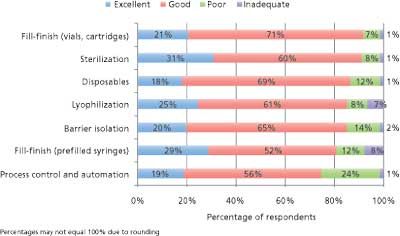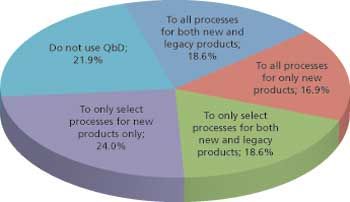Trends in Manufacturing and Equipment
PharmTech's annual equipment and manufacturing survey shows gains in process analytical technology and indicates areas for future innovation.

Pharmaceutical Technology’s annual equipment and manufacturing survey collected industry feedback on trends and the utility of equipment used in finished drug-product manufacturing. Respondents to both solid-dosage and parenteral drug manufacturing questions indicated overall satisfaction with existing equipment and equipment innovation. Data indicated that process analytical technology (PAT) is growing in use, but some users also noted a need for improvement in existing PAT equipment and in new solutions. A majority of respondents continue to view quality-by-design (QbD) principles as important, and more than 90% of respondents have a positive view of metrics and trend analysis. Responses also indicated further growth in continuous manufacturing and in manufacturing of highly potent drugs. Other areas of innovation to watch include robotics and software.
Solid-dosage equipment
Existing solid-dosage equipment is generally meeting industry needs. Only one area—PAT/in-process testing—was indicated as poor or inadequate by more than one-third of respondents (see Figure 1). Nearly one quarter of respondents also indicated that innovation is lacking in this area. This dissatisfaction is up from 2013, in which 22% indicated existing equipment was poor or inadequate and 16% said innovation was poor (1). It is interesting to note that use of PAT also increased over the past year among those surveyed. Process control/automation and powder transfer/materials handling were also flagged as needing significant improvement in existing equipment (25% and 21% respectively) and in innovation (17% and 12%); these areas were also noted in 2013.
Continuous manufacturing
The percentage of respondents involved in solid-dosage manufacturing that use continuous processes either overall or in select unit operations was nearly 40%, which was similar to 2013. Respondents expressed greater confidence in the evolution of continuous solid-dosage manufacturing, with nearly 85% predicting that the technology would evolve to allow fully continuous processing; in 2013, only 67% predicted such development of the technology. Just over one-third of respondents, however, predicted that the industry would only apply continuous processing to select operations even if fully continuous processes are available. Several individuals commented that, although continuous processing would work for high volumes, they didn’t see it being appropriate for small batch sizes. Half the respondents noted cost as a barrier to implementing continuous manufacturing, and over 40% also identified lack of expertise and insufficient PAT as barriers.
Parenteral equipment
The majority of parenteral-equipment respondents indicated that existing equipment is good or excellent, as shown in Figure 2. These respondents also agreed that innovation is generally keeping pace with most, if not all, of their needs. Innovation was rated as excellent or good in lyophilization (95%), barrier isolation (91%), disposables (91%), vial and cartridge fill-finish equipment (92%), and prefilled-syringe fill-finish equipment (85%). Process control and automation was a weaker area, similar to 2013, with approximately 25% saying that existing equipment is either poor or inadequate, and 18% saying that innovation is poor.
High-potency and high-containment
Just over one-third of respondents (in either solid-dosage or parenteral manufacturing) are involved with high-containment or high-potency manufacturing either in-house or at outsourced facilities. This percentage was up just slightly from last year’s survey; however, in 2014, 78% indicated an increase in their company’s level of activity over the past year up from 53% in 2013. When asked to identify the most challenging equipment or processing area, respondents’ answers were diverse, with 21% each indicating system setup/changeover and getting materials into or out of the system during production. Other areas chosen as the biggest challenge included containment (17%), ergonomics (14%), air flow (10%), environmental issues (9%), and personnel protection (7%). Training and cleaning validation were also identified as challenges.

Equipment metrics
Those surveyed overwhelmingly agreed that metrics and trend analysis enhance the ability to improve equipment operation (92% of respondents). Actual use of metrics lagged this response somewhat. Approximately 75% stated that they use trend analysis to measure process or product deviations and relate this to equipment performance; 73% report that their company culture encourages optimizing manufacturing quality using metrics and trend analysis. Approximately 66% of respondents said their company has a metric(s) specifically to measure unplanned downtime of equipment (i.e., equipment failure).

In both solid-dosage and parenteral areas, approximately half of respondents were aware of an equipment failure that had led to significant downtime or quality problems in the past year. When asked to identify the root cause(s), contamination or cleaning problems were most frequently chosen (44%), followed by utilities (37%), process validation (26%), nonconformance (25%), and other (11%) (multiple selections were allowed).
QbD
The majority of respondents use QbD principles in their manufacturing processes to some extent (see Figure 3). Approximately 35% apply QbD to all processes for new or all products, and nearly 43% apply QbD to select processes. Almost 22% indicated that they do not use QbD principles. Respondents noted several different challenges to implementing or barriers to using QbD (multiple answers allowed). The challenge most frequently identified was lack of knowledge or training (nearly 60% of respondents). Other challenges included lack of clarity in regulatory guidance (40%), management buy-in (38%), and availability of necessary equipment (35%) and software tools (31%). Nearly 10% said they saw no barriers or challenges.

PAT
In the five manufacturing areas surveyed, the use of PAT increased significantly since 2013 (see Figure 4), with 32-46% of respondents in 2014 indicating that they currently use PAT compared to 13-21% of respondents in 2013 (1). The primary drivers for using PAT (multiple answers possible) include better process understanding (56%), increased efficiency (39%), reduced costs (34%), and shorter process times (30%). The use of PAT should continue to grow; between 20 and 30% of respondents in 2014 indicate plans to implement PAT in the coming year. Approximately one-third of respondents (33-37% depending on the application), however, do not currently use PAT and do not plan to implement it in the coming year.

Areas for innovation
Given these plans to implement PAT and the respondents who said that existing PAT tools do not meet their needs, as discussed previously, PAT is an area ripe for suppliers to develop new and improved instruments.
When asked about the most important area for innovation in pharmaceutical manufacturing, respondents mentioned some of the topics surveyed, such as continuous processing, QbD, and PAT, and several respondents listed automation. “Robotics are an inevitability,” said one, and another commented, “Running ‘lights out’ [i.e., fully automated] would reduce the amount of hands-on time for production personnel.” Related comments included calls for improved software to eliminate human error. A wide range of methods and technologies, including those evaluated in this survey, will play a role in the continued drive to improve product quality and process efficiency.
Reference
1. J. Markarian, Pharm. Technol. 37 (4) 110-113 (2013).
About the Author
Jennifer Markarian is the manufacturing editor for Pharmaceutical Technology.

Pharmaceutical Tariffs Are Imminent: How Industry is Bracing for Impact
April 16th 2025On April 14, 2025, the Trump Administration launched a national security-driven investigation into pharmaceuticals, a move that will likely result in tariffs being placed on pharmaceutical drugs, ingredients, and other components that are imported from outside of the United States.
Drug Solutions Podcast: A Closer Look at mRNA in Oncology and Vaccines
April 30th 2024In this episode fo the Drug Solutions Podcast, etherna’s vice-president of Technology and Innovation, Stefaan De Koker, discusses the merits and challenges of using mRNA as the foundation for therapeutics in oncology as well as for vaccines.